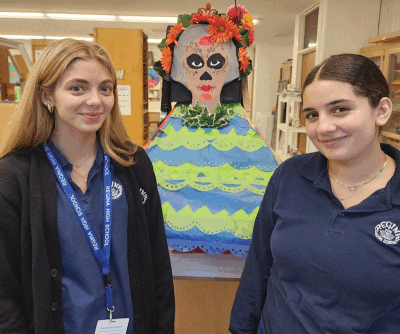
Regina junior Meah Higbee was responsible for the research and art for feminist nun Juana Inés de la Cruz.
Photo provided by Patricia Willoughby

Regina High School juniors Brynn Nida, left, and Evonna Karam researched botanist Ynés Mexia.
Photo provided by Patricia Willoughby
WARREN/DETROIT — Four women who made a strong impact, especially on Mexican American culture, are being remembered this year during the Detroit Institute of Arts’ Day of the Dead exhibit.
The stories of Ynés Mexia, Juana Inés de la Cruz, Frida Kahlo and Selena Quintanilla-Pérez are coming to life through the artwork of several Regina High School students who made a Day of the Dead “ofrenda” for the DIA. The exhibit opened to the public Sept. 23 and continues until Nov. 5.
The ofrendas are on display in the DIA’s Special Exhibitions galleries south of Rivera Court. According to the DIA website, dia.org, the museum’s 11th annual “Ofrendas: Celebrating el Día de Muertos” features 14 ofrendas by local artists and community members. The event was developed in partnership with the Consulate of Mexico in Detroit, the Southwest Detroit Business Association and Mexicantown Community Development Corp.
An ofrenda is an altar that is presented Nov. 1-2 — and sometimes Oct. 31 — to observe the Day of the Dead holiday, which is known as Día de los Muertos in Spanish. It coincides with the Catholic observances of All Saints’ Day Nov. 1 and All Souls’ Day Nov. 2.
On the altars, people place mementos of their departed loved ones. That could include favorite recipes, books, clothing, photos, stuffed animals, dolls, instruments and Christmas lights. Also, there are several traditional items that embellish an altar, including sugar skulls, candles, water, tissue paper with detailed cuts, and flowers — real, silk or paper. Vivid colors are part of creating the ideal ofrenda.
Working together, the Regina students made a four-sided altar to represent four women they honored. The students made the ofrenda under the direction of art teacher Patricia Willoughby; Melanie Hendrick, who teaches Spanish 2-5; and Michalyn Gret, who teaches Spanish 1 and Spanish 2, and an independent living class. At the end of the last school year, Regina submitted a proposal to the DIA.
“It was at the end of July we found out we were approved,” Willoughby said, adding the school received a $500 stipend to cover any expenses associated with the project. The students are scheduled to tour the DIA Oct. 24 to see the full exhibit in person.
Juniors Evonna Karam and Brynn Nida researched Ynés Mexia. The way Mexia (1870-1938) lived her life stood out. She wasn’t a typical woman of the era as she preferred trousers over dresses, traveled alone and became a botanist when she was in her 50s.
“She started her career at 55 and attended UC Berkeley,” Karam said.
“She was very inspiring,” Nida said.
Karam and Nida used their art skills to paint Mexia’s face and determine which items symbolize her life.
“We did vines and plants that represented her career,” Nida said.
“We also added flowers, a diploma, an airplane because she traveled a lot to find plants, and books because she was very intelligent,” Karam said.
Junior Meah Higbee was responsible for the research and art for Mexican-born Juana Inés de la Cruz, who lived from 1648 to 1695. According to Higbee’s research, the nun was known as the world’s first feminist. For symbols, Higbee used feathers, a cross, a notebook, and a crucifix.
For her participation, senior Yasmeen Sokol worked on artist Frida Kahlo, who was born in Mexico City in 1907 and died in Mexico City in 1954.
“I think she was very unique. She was known for her self-portraits and being really colorful. She was married to (painter) Diego Rivera twice,” Sokol said. “She wasn’t able to have children. She liked her unibrow. When it came to designing her, I put flowers, butterflies and braids to represent her.”
Senior Sophia Robotnik was assigned to work on the portrait of Selena Quintanilla-Pérez, who was known as Selena in the Tejano Tex-Mex pop scene. The 23-year-old singer began fronting the family band Selena y Los Dinos at age 9.
“She grew up speaking English. Her father taught her how to sing in Spanish,” Robotnik said. “She got very popular and famous and won awards. She married (guitarist) Chris Pérez. He loved her so much.”
In 1995, Quintanilla-Pérez was shot and killed by her fan club president, Yolanda Saldívar. To remember the singer, Robotnik used her favorite colors of black and purple on the ofrenda.
“I used a microphone and musical notes to represent her musical career, a crown because she was the queen of Tejano music, and roses because those were her favorite flowers,” Robotnik said.
Sophomores Amelia Lopez and Gabriela Velasco and junior Estrella Ignacio-Santillan — members of Regina’s World Culture Club — also were involved in the altar making by decorating body portions on all four sides. The students hope those who view the altars get a deeper understanding of the four women they honored.
“I want them to see all the women as role models,” Velasco said.
“I want them to see more into Mexican culture and the accomplishments,” Ignacio-Santillan said. “Sometimes, it’s not represented correctly.”
The World Culture Club meets monthly.
“We have a presentation of a different country,” Lopez said. “We learn about the culture and the food.”
The DIA is located at 5200 Woodward Ave., in Detroit. For hours or for more information, call (313) 833-7900 or visit dia.org.
 Publication select ▼
Publication select ▼



















